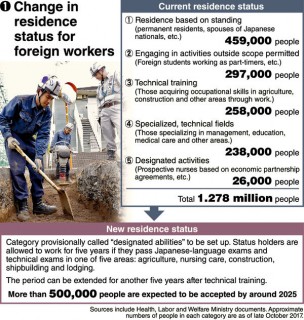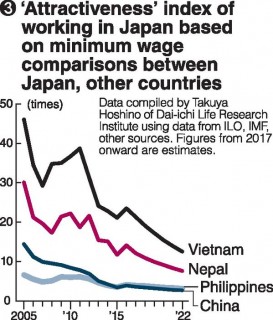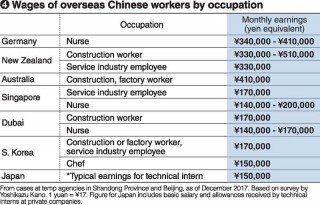Loading
Search
▼ Global Economy / Japan Competing With Asia For Labor
- Category:Tourism
How should Japan respond to labor shortages resulting from a declining population and graying society? Utilizing foreign workers is one of the government’s strategies. However, economic growth and declining populations are also expected throughout Asia. It appears doubtful that the intake of foreign workers will proceed as expected.
Policy change
Jovinerie Wagtang, 31, a Filipino who has worked for a homemaker service company since this February, sends about 70 percent of her salary back to her home country.
Filipinos skilled at domestic work are in great demand internationally. Although she received job offers with higher pay than in Japan, she decided to come here because of good working conditions like two days off per week and not having to be a live-in employee.
Domestic support work can be performed by foreigners in national strategic special zones, which are aimed at easing regulations in designated areas. Demand for such services, such as from dual-income households, is expected to rise, but it is difficult to secure Japanese workers to fill the positions.
Shinya Fukuda, an executive officer of Nichii Gakkan Co., the company that Wagtang works for, said: “We were able to expand our business as a result of the deregulation. Filipinos’ high skill level helped us.”
The government announced the expansion of the acceptance of foreign workers in the Basic Policy on Economic and Fiscal Management and Reform released in June. In the policy, a new residence status was created for industries with conspicuous labor shortages (see chart 1).
According to Junichi Akashi, an associate professor knowledgeable about immigration policy at the University of Tsukuba, the present debate on the acceptance of foreigners dates back to the 1980s.
Some financial circles sought approval of bringing in foreign workers, arguing it was essential to prevent the hollowing out of domestic industries, while the labor side warned that accepting foreign workers too easily would become a threat to domestic employment.
Policy change
Jovinerie Wagtang, 31, a Filipino who has worked for a homemaker service company since this February, sends about 70 percent of her salary back to her home country.
Filipinos skilled at domestic work are in great demand internationally. Although she received job offers with higher pay than in Japan, she decided to come here because of good working conditions like two days off per week and not having to be a live-in employee.
Domestic support work can be performed by foreigners in national strategic special zones, which are aimed at easing regulations in designated areas. Demand for such services, such as from dual-income households, is expected to rise, but it is difficult to secure Japanese workers to fill the positions.
Shinya Fukuda, an executive officer of Nichii Gakkan Co., the company that Wagtang works for, said: “We were able to expand our business as a result of the deregulation. Filipinos’ high skill level helped us.”
The government announced the expansion of the acceptance of foreign workers in the Basic Policy on Economic and Fiscal Management and Reform released in June. In the policy, a new residence status was created for industries with conspicuous labor shortages (see chart 1).
According to Junichi Akashi, an associate professor knowledgeable about immigration policy at the University of Tsukuba, the present debate on the acceptance of foreigners dates back to the 1980s.
Some financial circles sought approval of bringing in foreign workers, arguing it was essential to prevent the hollowing out of domestic industries, while the labor side warned that accepting foreign workers too easily would become a threat to domestic employment.
The latter half of the 1990s saw the beginning of a decline in the working-age population, defined as those aged 15 to 64, and voices in support of accepting foreign workers increased.
As of January this year, the working-age population fell below 60 percent of the entire population for the first time. It has become impossible to make up for the working-age population decrease just by raising employment rates for women and the elderly. In October 2017, the number of foreign workers reached about 1.28 million. Technical interns and foreign students (see below) have become indispensable sources of unskilled labor.
As of January this year, the working-age population fell below 60 percent of the entire population for the first time. It has become impossible to make up for the working-age population decrease just by raising employment rates for women and the elderly. In October 2017, the number of foreign workers reached about 1.28 million. Technical interns and foreign students (see below) have become indispensable sources of unskilled labor.
While maintaining a stance of responding carefully to the issue, the government has gradually opened the door to foreign workers. The June policy change is a “turning point that clearly positions the utilization of foreign workers as a countermeasure against labor shortages,” Akashi said.
Shrinking disparities
Whether Japan can maintain its competitiveness as a destination for foreign workers, however, is a separate issue.
Wages in Asia, an important supplier of labor, continue to rise due to economic growth. Looking at foreign workers in Japan by country of origin, China ranked top and the increase in the number from Vietnam stands out (see chart 2).
An “attractiveness” index (see chart 3) derived by comparing the minimum wage of four Asian countries with Japan’s is informative.
According to Takuya Hoshino of the Dai-ichi Life Research Institute, the index for China declined by three quarters from 2005 to 2016, while the index for Vietnam is predicted to fall by half from 2016 to 2022, based on economic growth forecasts.
Comparing increases in the minimum wage from 2010 to 2018, the figure approximately doubled in Beijing and increased by about 190 percent in Vietnam. But Japan saw a rise of only about 16 percent.
There are many cases in which the wages Chinese workers receive in Japan are lower than they would recieve in other countries (see chart 4).
Economic critic Yoshikazu Kano has warned, “Japan, with its stagnant wage growth, could earn a reputation as a low-wage country and lose its international competitiveness as a labor market.”
Shrinking disparities
Whether Japan can maintain its competitiveness as a destination for foreign workers, however, is a separate issue.
Wages in Asia, an important supplier of labor, continue to rise due to economic growth. Looking at foreign workers in Japan by country of origin, China ranked top and the increase in the number from Vietnam stands out (see chart 2).
An “attractiveness” index (see chart 3) derived by comparing the minimum wage of four Asian countries with Japan’s is informative.
According to Takuya Hoshino of the Dai-ichi Life Research Institute, the index for China declined by three quarters from 2005 to 2016, while the index for Vietnam is predicted to fall by half from 2016 to 2022, based on economic growth forecasts.
Comparing increases in the minimum wage from 2010 to 2018, the figure approximately doubled in Beijing and increased by about 190 percent in Vietnam. But Japan saw a rise of only about 16 percent.
There are many cases in which the wages Chinese workers receive in Japan are lower than they would recieve in other countries (see chart 4).
Economic critic Yoshikazu Kano has warned, “Japan, with its stagnant wage growth, could earn a reputation as a low-wage country and lose its international competitiveness as a labor market.”
In comparison with the United States and European countries, he also pointed out, “There has been a noticeably slow start here in areas such as agriculture in terms of technological innovation to replace manpower.”
Nor does Japan have an advantage in terms of accepting highly skilled workers.
According to a ranking by the Swiss business school IMD on countries that IT-related workers found it easiest to work in, Japan ranked 51st out of 63. Factors like long working hours hurt its standing.
The Economy, Trade and Industry Ministry estimates that in 2020 there will be a shortage of about 48,000 workers in the field of advanced areas in IT and about 190,000 workers in the field of information security. Such shortfalls could threaten the government’s vision of introducing robots and artificial intelligence to supplement the labor force.
China’s labor ‘shopping spree’
Labor shortages are not just Japan’s problem. For example, China is facing a similar trend — and that has a big impact on Japan.
In China, which saw its working-age population peak in 2015 and corrected the course of its one-child policy, the total population is expected to begin to fall as early as 2025. There are measures that could be implemented to address the issue, such as reviewing the family registration system that restricts people’s ability to move to different parts of the country.
Hirotoshi Kishi of Nomura Research Institute said, “A labor shortage will be recognized as an important challenge, triggered by a decline in the entire population.”
According to overseas media, the number of Philippine women working in China as homemakers has reached the 200,000 range, with many of them supporting dual-income households.
Kano said that if this trend spreads to other categories of business and China starts a “shopping spree” for Asian labor, then Japan will be competing with China for workers from Vietnam and the Philippines.
Overseas precedents
Given the accelerating pace of labor migration in Asia, the success of a country’s acceptance of foreign workers will largely depend on how the country can improve its working environment for them.
The German government tried to resolve a shortage of nursing care workers as a result of its graying population by taking in workers from former Eastern Bloc countries, but was unable to prevent the workers from migrating on to countries where wages were higher, such as Britain. As in Japan, it is difficult for Germany to flexibly raise caregivers’ wages.
Germany has been trying to attract nursing care workers from China and the Philippines.
But the overseas precedent shows that “a labor shortage cannot be resolved without an improvement of working conditions for these workers,” said Miku Ishibashi of Daiwa Institute of Research.
A review of low wages, long working hours and burdensome levels of customer service is essential for Japan to prepare and improve working conditions for foreign workers. Tackling the long-standing problems of raising wages and increasing productivity through technological innovation is an urgent task.
■Technical interns / foreign students
In Japan, foreigners can only be approved for work-related residency if they have highly specialized occupations. Technical internships are aimed at technological transfer and international contribution through human resources training.
Technical internships are widely seen in such fields as construction, manufacturing and agriculture. Foreign students, who are allowed to work part-time for up to 28 hours per week, have also become a valuable labor force for businesses like convenience stores.
Nor does Japan have an advantage in terms of accepting highly skilled workers.
According to a ranking by the Swiss business school IMD on countries that IT-related workers found it easiest to work in, Japan ranked 51st out of 63. Factors like long working hours hurt its standing.
The Economy, Trade and Industry Ministry estimates that in 2020 there will be a shortage of about 48,000 workers in the field of advanced areas in IT and about 190,000 workers in the field of information security. Such shortfalls could threaten the government’s vision of introducing robots and artificial intelligence to supplement the labor force.
China’s labor ‘shopping spree’
Labor shortages are not just Japan’s problem. For example, China is facing a similar trend — and that has a big impact on Japan.
In China, which saw its working-age population peak in 2015 and corrected the course of its one-child policy, the total population is expected to begin to fall as early as 2025. There are measures that could be implemented to address the issue, such as reviewing the family registration system that restricts people’s ability to move to different parts of the country.
Hirotoshi Kishi of Nomura Research Institute said, “A labor shortage will be recognized as an important challenge, triggered by a decline in the entire population.”
According to overseas media, the number of Philippine women working in China as homemakers has reached the 200,000 range, with many of them supporting dual-income households.
Kano said that if this trend spreads to other categories of business and China starts a “shopping spree” for Asian labor, then Japan will be competing with China for workers from Vietnam and the Philippines.
Overseas precedents
Given the accelerating pace of labor migration in Asia, the success of a country’s acceptance of foreign workers will largely depend on how the country can improve its working environment for them.
The German government tried to resolve a shortage of nursing care workers as a result of its graying population by taking in workers from former Eastern Bloc countries, but was unable to prevent the workers from migrating on to countries where wages were higher, such as Britain. As in Japan, it is difficult for Germany to flexibly raise caregivers’ wages.
Germany has been trying to attract nursing care workers from China and the Philippines.
But the overseas precedent shows that “a labor shortage cannot be resolved without an improvement of working conditions for these workers,” said Miku Ishibashi of Daiwa Institute of Research.
A review of low wages, long working hours and burdensome levels of customer service is essential for Japan to prepare and improve working conditions for foreign workers. Tackling the long-standing problems of raising wages and increasing productivity through technological innovation is an urgent task.
■Technical interns / foreign students
In Japan, foreigners can only be approved for work-related residency if they have highly specialized occupations. Technical internships are aimed at technological transfer and international contribution through human resources training.
Technical internships are widely seen in such fields as construction, manufacturing and agriculture. Foreign students, who are allowed to work part-time for up to 28 hours per week, have also become a valuable labor force for businesses like convenience stores.
- July 30, 2018
- Comment (0)
- Trackback(0)





